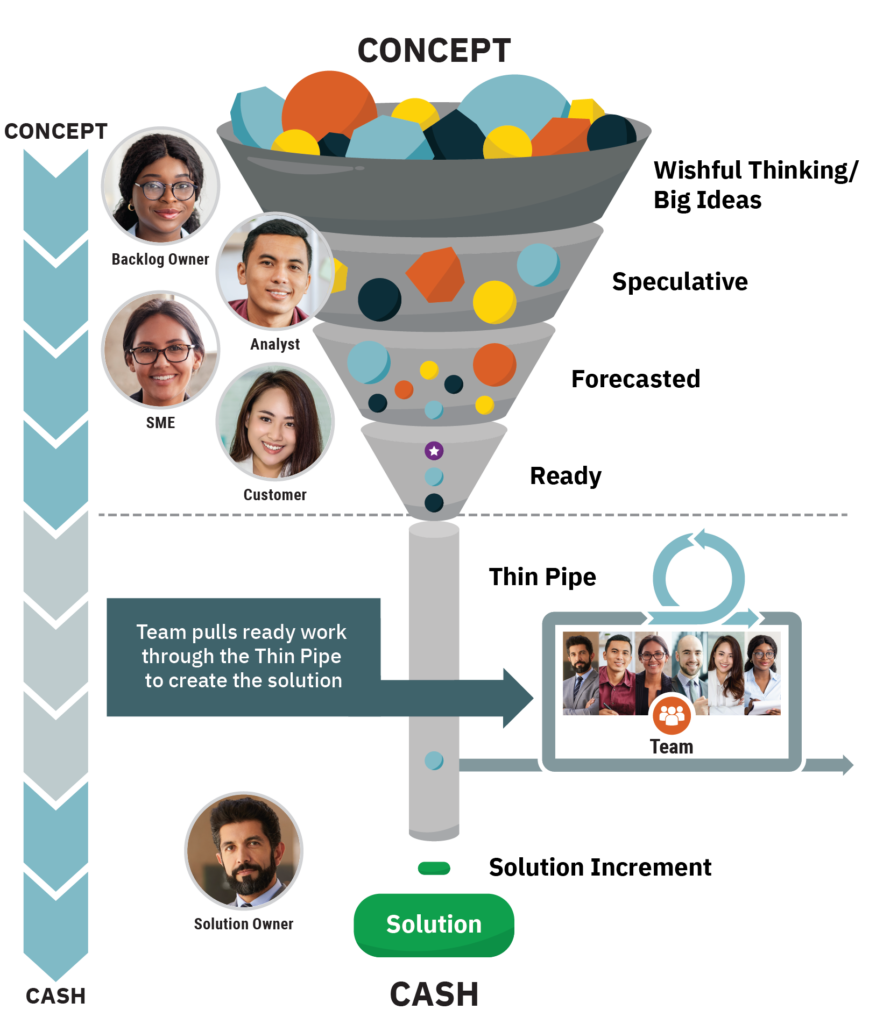What is Lean?
Lean is a way of thinking about creating needed value with fewer resources and less waste [ Lean Enterprise Institute]
What Are the 5 Principles of Lean?
- Precisely specify value by product.
- Identify the Value Stream for each product
- Make value flow without interruption
- Let the customer pull value from the producer
- Pursue Perfection
Precisely Specify Value By Product
A very simple question yet likely to start an existential crisis in many enterprises: do we know what the products or services we offer are?
In the Rock Crusher, the product is represented by the Rock Crusher Solution.
Without a shared clear understanding of the product, we will not have a good criteria for judging the value of Rocks. In our blog post “What did 50 Business Analysts Say Were Their Biggest Challenges with Blacklog Management” a common theme was no clear priority which implies there was a lack of clarity for what the product is, and how the product creates value. This is why the second step of the Rock Crusher Canvas is “Choose a value stream”. Of course to choose a value stream you have to know what your products and value streams are.
Identify the Value Stream for each Product
Even if you know what your product is, do you know how you make it? Once again, this is a question that can trigger yet another existential crisis within an enterprise. A value stream is
All of the actions, both value-creating and nonvalue-creating, required to bring a product from concept to launch (also known as the development value stream) and from order to delivery (also known as the operational value stream). These include actions to process information from the customer and actions to transform the product on its way to the customer.
Lean Enterprise Institute – Value Stream
A value stream is a powerful tool for understanding how we get things done, and for improving how we get things done. A value stream has a triggering event, a series value add steps that lead to delivery of value to a customer (our product or service). One key metric is the lead time from the trigger event (e.g. “I want…”) until value exchange. After all the whole point of Lean is getting economic value from shortening the lead time.

The simplicity of the value stream betrays its relevance and importance as a tool for succeeding in the age of software. As Karen Martin and Mike Osterling wrote:
if you can’t describe what you‘re doing as a value stream, you don’t know what you‘re doing
Karen Martin, Mike Osterling, Value Stream Mapping
For the Rock Crusher to be truly effective in an enterprise it is necessary to align the Rock Crusher with your value stream. Otherwise all it will do is create an illusion of success.

Make Value Flow Without Interruption
In the Lean world, flow is almost the equivalent of the search for the Holy Grail. Lean is about removing delay creating waste:
Producing and moving one item at a time (or a small and consistent batch of items) through a series of processing steps as continuously as possible, with each step making just what is requested by the next step.
Lean Enterprise Institute
Al Shalloway remaked about waste will manifest as a delay. A significant source of delay are stage gates and coordination delays. Our beloved backlog may actually be a significant source of delay because in reality it encourages over product and inventory which are two significant Lean wastes. The purpose of the Rock Crusher is to make us aware of the need for Lean thinking through the whole product development value stream. Not just the coding steps.
Let the Customer Pull Value From the Producer
The long lead time and lack of feedback in product development has lead to a “spray and pray” approach to product management. Product Managers ask their tech teams to create as many features as they imagine may be useful because they do not have actionable data to tell them what features customers actually desire. This is an example of where Product managers are “pushing” features based on what they think their customers need.
When we short lead times, not just for coding, but for the entire product development stream, then we can adopt a classic Lean Startup Build-Measure-Learn cycle to discover what the customer really wants. This is what happened when Toyota merged its Motor Sales and Motor Manufacturing companies and reduce the lead time for delivering a car from 30 days to 6 days. They were able to go from selling whatever was on the lot, to selling what the customer actually wanted. The result is they were able to command higher margins on their products [An Overlooked Lesson From Toyota].
Pursue Perfection
A perfect lead time is zero. While we will never achieve that we can always seek out ways to reduce the lead time from trigger to delivery.